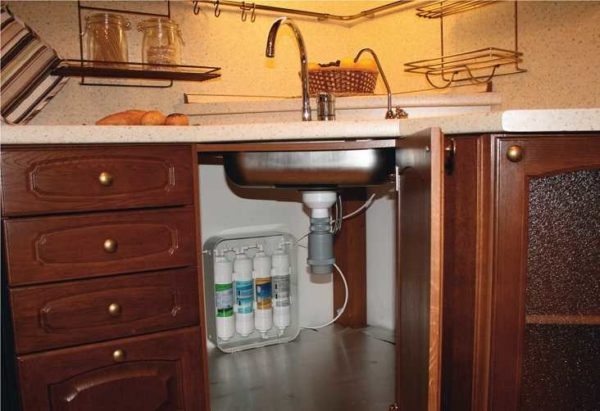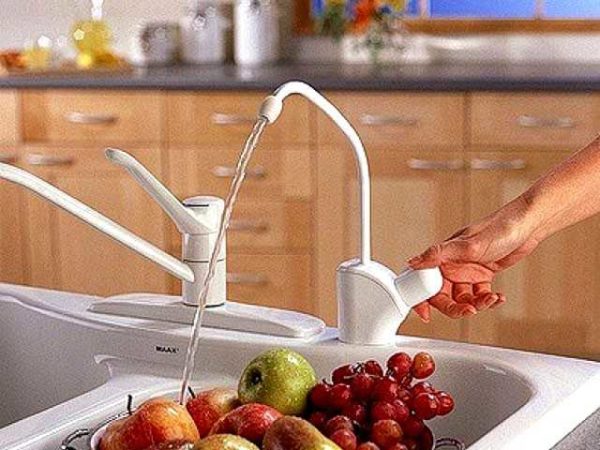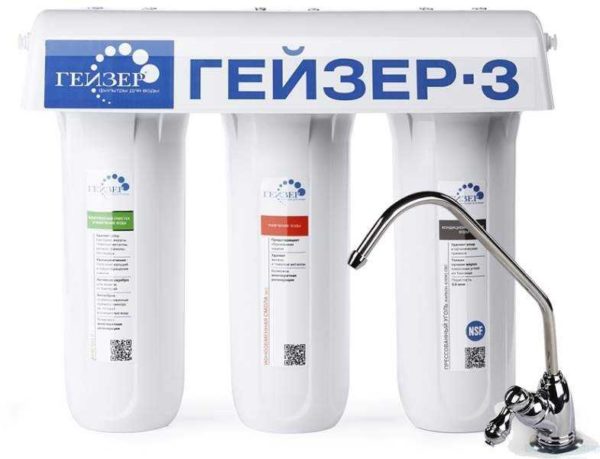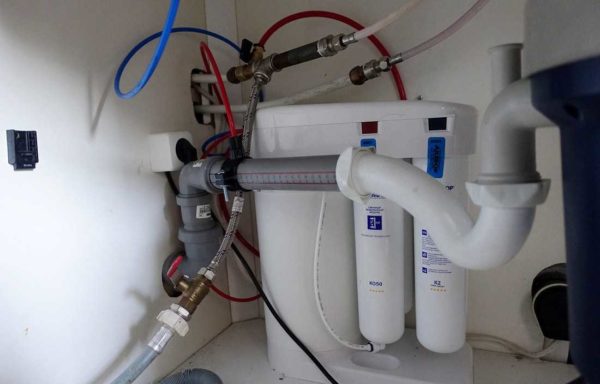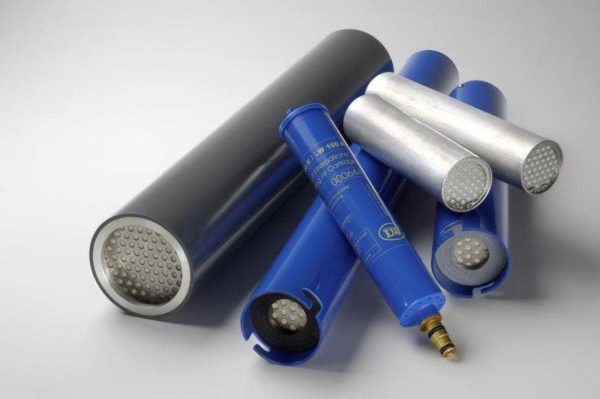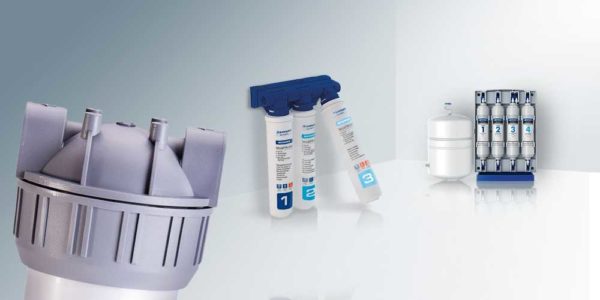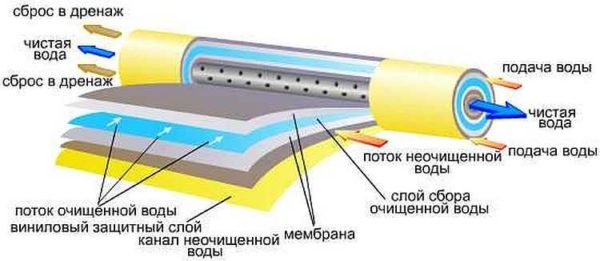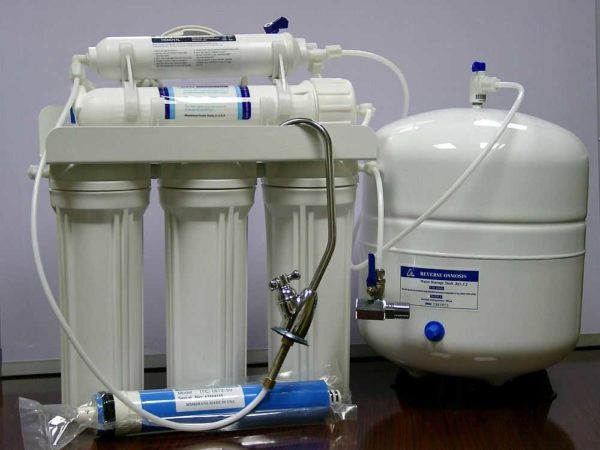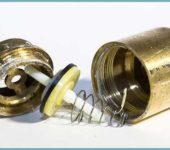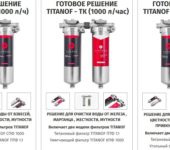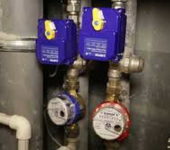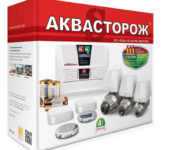How to choose a water filter for a sink
Most of the tap water in our taps is unusable. In order not to buy bottled, you can clean what you have to the desired state. One way is to install a water filter under the sink. They are usually equipped with a small crane and are easy to install. Their disadvantage is a decent price and the need to replace cartridges. But they purify water well, which corresponds to GOST.
The content of the article
Types of filters for washing
To obtain drinking water at home, there are two types of water filters for washing - flowing cartridge filters and using reverse osmosis technology (reverse osmosis system). These stationary models are very similar in appearance. They consist of several plastic flask-bodies, in which the filter elements are located. The reverse osmosis system has an additional flask with a membrane.
Cartridge and reverse osmosis system - what's the difference
The main difference between the reverse osmosis system is the use of a special semi-permeable membrane. The whole point of this purification is that only water molecules pass through the very small pores of the membrane. Organic and inorganic substances dissolved in it simply do not pass. Everything is delayed, even bacteria and microbes.
The degree of water purification by reverse osmosis systems is 98–99%. That is, at the exit we get practically distilled water, which has neither taste nor smell. Long-term use of such a liquid leads to the leaching of salts from the body. Therefore, a mineralizer is placed at the outlet of the reverse osmosis system, in some models it is immediately included in the package. This is an additional flask, which contains a filling of useful minerals. It enriches the composition of water, brings it to normal.
When using stationary flow-through cartridge filters under the sink, you will not get so pure water. Reverse osmosis removes salts, and flow filters (and jugs too) remove them partially. The difference is understandable and tastes good. In addition, after the flow-through filter, scale remains in the teapot, but it has a different character, becomes looser and can be easily removed.
When using cartridge filters, one cannot say that the purification is poor (about 70–80% versus 95–98% for reverse osmosis), but without a bacterial purification stage (there are such filter elements with silver additives) drinking it without boiling can be risky.
Features of operation
In fact, cartridge systems and reverse osmosis systems are multi-stage filters, which involves regular replacement of filter elements. Each such element has a certain resource, which is usually indicated in liters, this is how much water it can process without losing quality. Or they often indicate in parallel a time interval of six months, a year, etc. That is, even if the filter has not worked out its resource, it must be changed. It's just that microorganisms accumulate in them, which, if the deadlines are violated, can enter the water in large quantities.
There is another situation, water quality deteriorates even before the specified time interval and resource. This happens with an increased level of contamination and the filter depletes its resource much faster.There are two ways out: change the filter elements as they become dirty, or put an additional cleaning stage before installation, which solves this problem.
Selection features
The good thing about the cartridge system is that you can select filter elements depending on the composition of the water (we are talking about both systems). Therefore, before buying, it makes sense to analyze the water, and then select the composition of the filters in order to purposefully remove the existing problem. For example, reverse osmosis systems do not work well on water with a high iron content. If you have such a problem, before installation, you need to install equipment for iron removal (aeration units or catalytic filters) and only after them you can already connect reverse osmosis filters.
Second point: for normal operation of reverse osmosis requires a decent pressure. Depending on the type of membrane, 1.5 atm (50G) or at least 3 atm (100G) is required. If there is no such pressure in your water supply system, you must either take the installation with a pump (expensive and few), or put it into the systempump that increases pressure.
Reverse osmosis is connected to the sewage system. There he drains the concentrate of salts, which are removed from the water. If you are planning an installation in a private house, and you have a drain pit or storage tank, you need to keep this in mind. A decent volume goes into the sewer system, for each liter of purified water 2–4 liters of concentrate are drained (depending on the hardness). The multi-stage cartridge filter is connected only to the water supply, and all salts removed by it remain in the filters.
Since reverse osmosis removes almost all salts, with prolonged use of such water, salts are excreted from the body. To solve this problem, a mineralizer is placed at the filter outlet - this is a flask filled with mineral salts. It can be assembled, or you can put it after the filter. I just have to say that drinking water without mineralization is more pleasant than "salted" water, and the taste of dishes on such water is better. Therefore, many manufacturers provide for two modes of operation - with or without a mineralizer (switched by a tap).
Here's all the information that can somehow influence your choice between a multi-stage purification filter and reverse osmosis. To say specifically that these water filters installed in the kitchen are good, but these are not, none of the experts will say. Everyone has their own point of view, and for everyone, their own version is better. And each system has its own advantages.
Multi-stage cartridge filters
Cartridges have their own parameters. In addition to the list of contaminants that it removes and physical dimensions, they also indicate a resource - the number of liters of water that this element can purify. It is usually indicated in liters, but often they also put a time resource, no more than 3 months, for example.
Popular cartridge filter models
Filters installed under the sink are most often three-flask (three-stage), less often there are models with four cases. In any case, the mechanical filter is put first, then the ion-exchange filter and the last carbon filter. If there are four elements, two coal ones are placed, but with different types of backfill. Sometimes bioprotection is put on the fourth stage, a new generation of filters with silver for disinfection.
The most popular brands are Aquaphor, Geyser, Barrier; products under the Atoll brand have shown themselves well. Choose a system primarily according to the hardness of the water, it is divided into normal, hard, very hard. If there are other problems, such as the need for bacterial cleaning, look for models that can give you such cleaning. Then look at performance and dimensions.
| Name | Performance | Purified water temperature | Operating pressure | Number of cleaning stages | For what water | Price | Manufacturer country |
|---|---|---|---|---|---|---|---|
| Barrier "Expert Standard" | 2 l / min | from + 5 ° С to + 35 ° С | up to 7 atm | 3 | Normal hardness | 40$ | Russia |
| Barrier "Expert Complex" | 2 l / min | from + 5 ° С to + 35 ° С | up to 7 atm | 3 | For hard water with a high iron content | 95$ | Russia |
| Barrier "Expert Ferrum" | 2 l / min | from + 5 ° С to + 35 ° С | up to 7 atm | 3 | For water of normal hardness with a high iron content | 62$ | Russia |
| Geyser 2PK Lux | 2.5 l / min | up to + 40 ° C | not less than 0.5 atm | 2 | Normal hardness (no mechanical filter) | 33$ | Russia |
| Geyser 2IVZh Lux | 2.5 l / min | up to + 40 ° C | not less than 0.5 atm | 2 | Rigid (no mechanical filter) | 35$ | Russia |
| Geyser 3 IVZH lux | 3 l / min | up to + 40 ° C | from 0.5 atm to 7 atm | 3 | For hard water | 53$ | Russia |
| AQUAPHOR CRYSTAL A | 2.5 l / min | from + 5 ° С to + 40 ° С | from 0.63 atm to 6.3 atm | 3 | For medium hard water | 40$ | Russia |
| AQUAPHOR Crystal KVADRO HНB | 2.5 l / min | from + 5 ° С to + 40 ° С | from 0.63 atm to 6.3 atm | 3 | For very hard water | 103$ | Russia |
| AQUAPHOR Trio Fe | 2.5 l / min | from + 5 ° С to + 40 ° С | from 0.63 atm to 6.3 atm | 3 | For water with a high iron content | 60$ | Russia |
| Crystal ECO | 2.5 l / min | from + 5 ° С to + 40 ° С | from 0.63 atm to 6.3 atm | 3 | For water disinfection | 75$ | Russia |
| Praktic EU200 | 1-2 l / min | from + 5 ° С to + 35 ° С | from 1.4 atm to 7.9 atm | 3 | For water with increased hardness | 35$ | Germany |
| Praktic EU312 | 1-2 l / min | from + 5 ° С to + 35 ° С | from 1.4 atm to 7.9 atm | 4 | For water with a lot of iron | 85$ | Germany |
| Praktic EU320 | 1-2 l / min | from + 5 ° С to + 35 ° С | from 1.4 atm to 7.9 atm | 4 | For water of increased hardness, ultrafiltration | 100$ | Germany |
| Atoll A-211E g / D-21s STD | from + 5 ° С to + 40 ° С | up to 6 atm | 2 | For post-treatment of drinking water | 98$ | ||
| Atoll A-211E g / D-21s STD | from + 5 ° С to + 40 ° С | up to 6 atm | 3 | For hard water | 125$ |
To say that one of these manufacturers cannot be better, all of them have an approximately equal number of positive and negative reviews. The Barrier filter manufacturers have a very poor customer service, although the products themselves are not bad. It cannot be said that Geyser is ideal in this regard, but things are a little better. In general, Russian manufacturers cannot yet please with a high-quality service department, so you will have to deal with all the problems yourself.
Another tip that can come in handy when choosing a filter, look not only at the cost of the kit. Much more important is the cost of consumables (cartridges) and their standard sizes, connection methods. Ease of service is also important, filters will have to be changed, so easy replacement is a plus.
Reverse osmosis systems
Under the sink in the kitchen, you can put multistage water purification filters operating on the principle of reverse osmosis. They are ideal if the water is too abnormal. When installing a conventional multi-stage filter, it is very difficult to achieve the required water quality; most likely, several more single installations will need to be added to the system, which will allow to achieve water of normal quality. Reverse osmosis in any case copes with the task, the difference is simply in the amount of water that will merge with the removed salts into the sewer (the harder and more polluted the water, the more the concentrate is discharged).
Principle of operation
The reverse osmosis system consists of membranes with very small pore sizes. Almost all substances in water, including microorganisms, bacteria and microflora, have molecular sizes exceeding those of water molecules. And the pores in the membrane are so small that only water passes through them. There are very few foreign substances penetrating through the membrane - no more than 0.5-2% of the total amount of water.
On the other hand, all salts remain on the membrane surface. So that they do not pollute it, they are diverted by a stream of water into the sewer.
Features of operation
The size of the membrane for the cartridge is standard. Only the specific characteristics of the membranes are added. They are of two types in terms of performance:
- 50G with a capacity of up to 196 l / day (about 130 ml / min);
- 100G - water purification rate of about 400 l / day (280 ml / min).
The first type of membranes is cheaper, the second is more expensive. To ensure their operation, a certain pressure is required, for 50G at least 1.5 atm, for 100G at least 3 atm.If there is no such pressure in the system, you can find an installation with a built-in pump, you can set it yourself, choosing it according to the parameters of the system.
One more point: water filters for washing with reverse osmosis do not like too chlorinated or ferruginous water. In principle, there are prefilters in front of the membrane that eliminate this problem, but pay attention to what type of water this system is intended for.
One more nuance: such treatment plants work rather slowly, a glass or half in a minute, this is quite a bit. Therefore, the kit often comes with a tank for storing purified water. This is not just a container, but a membrane-type tank that maintains a certain pressure inside. Therefore, purified water can be used even when there is no pressure in the water supply system. Just remember that the characteristics indicate the total volume of the tank. In reality, the water supply in it is about 2 times less.
Some popular models
Since the systems are very similar, they are produced by the same companies as conventional cartridge systems for water purification and softening, so new names are rare. In descending order of popularity: Geyser, Aquaphor, Atoll, Barrier. The characteristics of some models are summarized in the table. From it you can get a general idea of the order of prices and the difference in characteristics, but each of the models usually has several modifications.As a rule, for water of different hardness or with different additional problems (high iron content, bacterial contamination, etc.).
| Name | Performance | Operating pressure | Number of cleaning stages | Water temperature | Tank for water | Price |
|---|---|---|---|---|---|---|
| Atoll A-550 Patriot | 120 l / day | 2.8 - 6.0 bar | 5 | 4 ° C - 38 ° C | there is | 130$ |
| Atoll A-575E (Russian production) | 195 l / day | 2.8 - 6.0 bar | 5 | 4 ° C - 38 ° C | there is | 200$ |
| Aquaphor DWM-101S Morion (with mineralizer) | 187 l / day | 2 - 6.5 atm | 6 | 5 ° C - 38 ° C | tank 5 l | 120$ |
| Aquaphor Crystal Eco N (bacterial protection for hard water) | 60 l / day | 2 - 6.5 atm | 4 | 5 ° C - 38 ° C | no | 90$ |
| Geyser Prestige-P with pump | 270 l / day | from 1.5 atm | 5 | 5 ° C - 38 ° C | tank 12 l | 180$ |
| Geyser Prestige-M (with mineralizer) | 200 l / day | from 3 atm | 6 | 5 ° C - 38 ° C | tank 12 l | 130$ |
| Barrier Profi Osmo 100 | 228 l / day | 3 - 7 atm | 5 | 5 ° C - 35 ° C | tank 8 l | 140$ |
| K-OSMOS barrier (with pump) | 200 l / day | 3 - 7 atm | 4 | 5 ° C - 35 ° C | bek 8 l | 120$ |
What else you need to know about reverse osmosis systems, they must be operated constantly. Long breaks are highly undesirable.

